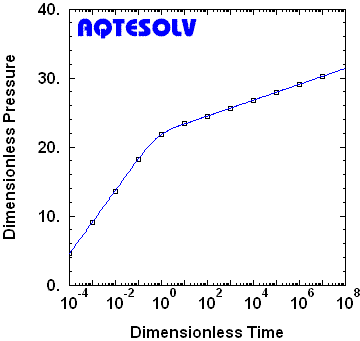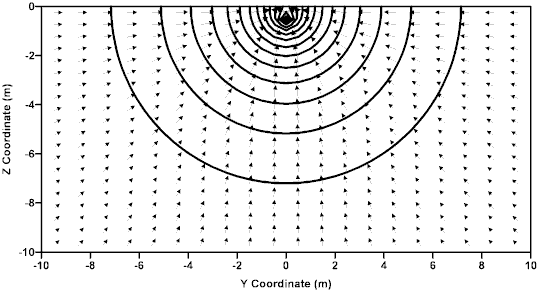Daviau et al. Solution for Horizontal Wells in Confined Aquifers
- Assumptions
- Equations
- Data requirements
- Solution options
- Estimated parameters
- Curve matching tips
- Benchmark
- Example
- References
Related Solution Methods
Additional Topics

A mathematical solution for horizontal wells by Daviau et al. (1985) is useful for determining the hydraulic properties (transmissivity, storativity and hydraulic conductivity anisotropy ratio) of nonleaky confined aquifers. Analysis involves matching the Daviau et al. solution to drawdown data collected during a pumping test in a horizontal well.
When you choose a solution, AQTESOLV provides two options for the Daviau et al. solution: uniform-flux and infinite-conductivity horizontal wells.
You are not restricted to constant-rate tests with the Daviau et al. solution. Using the principle of superposition in time, AQTESOLV can simulate variable-rate and recovery tests with this method.
Assumptions
- aquifer has infinite areal extent
- aquifer is homogeneous, anisotropic and of uniform thickness
- potentiometric surface is initially horizontal
- aquifer is nonleaky confined
- pumping well is horizontal
- observation wells are fully or partially penetrating
- flow is unsteady
- water is released instantaneously from storage with decline of hydraulic head
- diameter of the horizontal well is very small so that storage in the well can be neglected
Equations
The following equation by Daviau et al. (1985) and Clonts and Ramey (1986) predicts drawdown around a uniform-flux horizontal well in an anisotropic nonleaky confined aquifer:
where
- is aquifer thickness [L]
- is radial (horizontal) hydraulic conductivity [L/T]
- is vertical hydraulic conductivity [L/T]
- is length of the well open interval [L]
- is pumping rate [L³/T]
- is radial distance from pumping well to observation well [L]
- is well radius [L]
- is drawdown [L]
- is storativity [dimensionless]
- is elapsed time since start of pumping [T]
- is transmissivity [L²/T]
- , and are coordinate distances [L]
Drawdown in an observation well may be found by integrating the preceding equations with respect to z.
Following the work of Daviau et al. (1985), Clonts and Ramey (1986) and Ozkan et al. (1989), drawdown in the wellbore is computed with
Clonts and Ramey (1986) and Ozkan et al. (1989), citing the work of Gringarten, Ramey and Raghavan (1974), set = 0.732 in the uniform-flux solution to compute drawdown in an infinite-conductivity horizontal well.
Data Requirements
- pumping and observation well locations
- pumping rate(s)
- observation well measurements (time and displacement)
- aquifer thickness
- length of horizontal well
Solution Options
- constant or variable pumping rate with recovery
- multiple horizontal wells
- multiple observation wells
- partially penetrating observation wells
Estimated Parameters
AQTESOLV provides visual and automatic methods for matching the Daviau et al. method to data from pumping tests and recovery tests. The estimated aquifer properties are as follows:
- (transmissivity)
- (storativity)
- (hydraulic conductivity anisotropy ratio)
Curve Matching Tips
- Use the Cooper and Jacob (1946) solution to obtain preliminary estimates of aquifer properties.
- Choose Match>Visual to perform visual curve matching using the procedure for type curve solutions.
- Use active type curves for more effective visual matching with variable-rate pumping tests.
- Select values of from the Family and Curve drop-down lists on the toolbar.
- Use parameter tweaking to perform visual curve matching and sensitivity analysis.
- Perform visual curve matching prior to automatic estimation to obtain reasonable starting values for the aquifer properties.
Benchmark

Example

References
Daviau, F., Mouronval, G., Bourdarot, G. and P. Curutchet, 1985. Pressure analysis for horizontal wells, SPE Paper 14251, presented at the 60th Annual Technical Conference and Exhibition in Las Vegas, NV, Sept. 22-25, 1985.